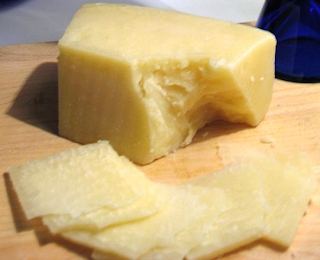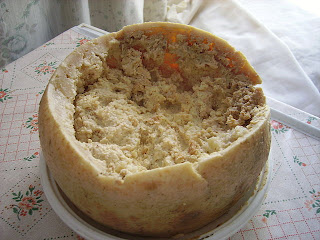Article may/may not be related to apricots*
The Casu Marzu is a traditional Sardinian sheep milk cheese, that happens to have a extra "umfp" than your regular cheeses. While we've all heard of those "aged cheeses" that cost a few thousands dollars due to the hundreds of years worth of effort put into them. Casu Marzu takes "aging cheese" one step further by going beyond the typical fermentation stage, and goes into some crossroad between insanity, torture, and decomposition. How? Why? We'll explain.
The Casu Marzu brings about this "super-advanced" aging process by using the helpful assistance of the Fruit fly. To be more specific, the larvae of the Cheese fly. In order to establish the natural soft texture taste, the larvae of the Fruit fly are introduced to the cheese in order to break down the cheese's fats and therefore bringing it to the next level of
To start the process, a roll of Pecorino, a hard sheep milk cheese, is brought outside with some portions of the outer layer removed in order to allow the cheese fly to lay their juicy eggs onto the cheese. Shortly afterwards, the eggs hatch by the thousands and the larvae begin to crawl around the cheese, eating what they can to become the top-dog of the cheese roll. After some time, the acid from the maggots' digestive system would soften the texture of the cheese, rendering the texture from hard and brittle to soft and luscious. After the entire cheese is "processed" by these magnificent, 0.3 inch, white-translucent worms, the cheese is ready to be eaten.
Pictured: Percorino
When I said that the cheese was ready to be eaten, I wasn't kidding. At that point, you can grab the roll of cheese and eat it maggot and all. In fact, it's considered unsafe to be eaten if the maggots have died. To make the experience more enjoyable beyond the thought of eating thousands of 0.3 inch worms in cheese, these worms are known to throw themselves up to six inches into the air, when disturbed from their restful home. If you were trying to cut yourself a nice block of cheese, you'll have thousands of blurred lines jumping across your face, falling onto your hands and clothes as you attempt to enjoy yourself.
For more civilized people that enjoy a nice block of maggot-less cheese, it's possible to seal the cheese in a air-tight paper bag and wait until the worms die of oxygen. How that works is that the maggots will begin to jump out of the cheese, making a sound comparable to rain onto a tin roof, as they run out of oxygen. Once the tip-taps end, you can open the bag, brush off thousands of dead worms, and enjoy your cheese. Elegant, right?
Deliciousness at its finest.
If you choose to eat the larvae alive, you may find yourself with another predicament (considering that you've just eaten a block of cheese full of maggots) involving a parasitic relationship. If these Cheese fly larvae are eaten alive, they can usually pass through your digestive system relatively unharmed and live in your intestines for a undetermined amount of time. These larvae can eventually create severe intestinal lesions as they attempt to burrow through your intestine walls and fail. (Hopefully.) The result of these lesions are nausea, vomiting, bloody diarrhea, and pain. Eventually, these larvae will come out of your stool, deal or alive.









